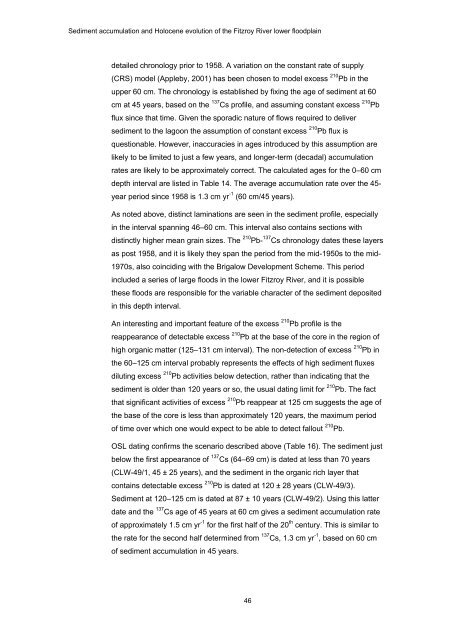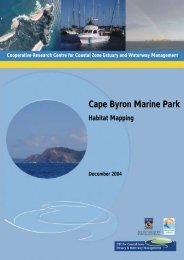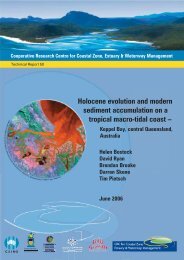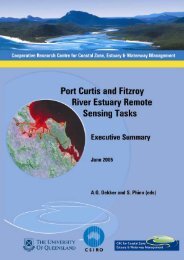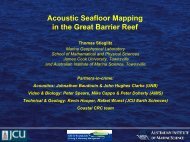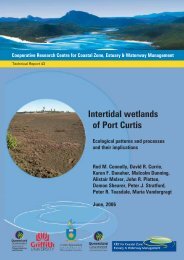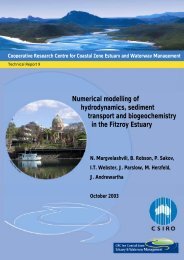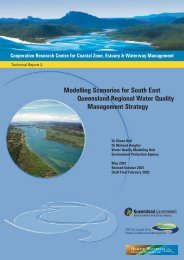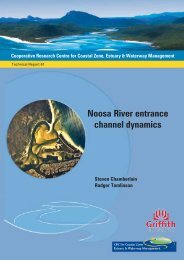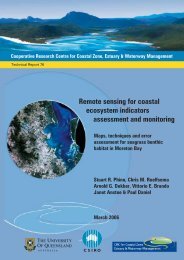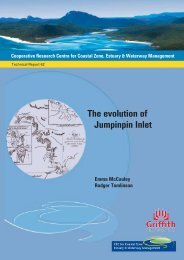Sediment accumulation and Holocene - OzCoasts
Sediment accumulation and Holocene - OzCoasts
Sediment accumulation and Holocene - OzCoasts
Create successful ePaper yourself
Turn your PDF publications into a flip-book with our unique Google optimized e-Paper software.
<strong>Sediment</strong> <strong>accumulation</strong> <strong>and</strong> <strong>Holocene</strong> evolution of the Fitzroy River lower floodplain<br />
detailed chronology prior to 1958. A variation on the constant rate of supply<br />
(CRS) model (Appleby, 2001) has been chosen to model excess 210 Pb in the<br />
upper 60 cm. The chronology is established by fixing the age of sediment at 60<br />
cm at 45 years, based on the 137 Cs profile, <strong>and</strong> assuming constant excess 210 Pb<br />
flux since that time. Given the sporadic nature of flows required to deliver<br />
sediment to the lagoon the assumption of constant excess 210 Pb flux is<br />
questionable. However, inaccuracies in ages introduced by this assumption are<br />
likely to be limited to just a few years, <strong>and</strong> longer-term (decadal) <strong>accumulation</strong><br />
rates are likely to be approximately correct. The calculated ages for the 0–60 cm<br />
depth interval are listed in Table 14. The average <strong>accumulation</strong> rate over the 45-<br />
year period since 1958 is 1.3 cm yr -1 (60 cm/45 years).<br />
As noted above, distinct laminations are seen in the sediment profile, especially<br />
in the interval spanning 46–60 cm. This interval also contains sections with<br />
distinctly higher mean grain sizes. The 210 Pb- 137 Cs chronology dates these layers<br />
as post 1958, <strong>and</strong> it is likely they span the period from the mid-1950s to the mid-<br />
1970s, also coinciding with the Brigalow Development Scheme. This period<br />
included a series of large floods in the lower Fitzroy River, <strong>and</strong> it is possible<br />
these floods are responsible for the variable character of the sediment deposited<br />
in this depth interval.<br />
An interesting <strong>and</strong> important feature of the excess 210 Pb profile is the<br />
reappearance of detectable excess 210 Pb at the base of the core in the region of<br />
high organic matter (125–131 cm interval). The non-detection of excess 210 Pb in<br />
the 60–125 cm interval probably represents the effects of high sediment fluxes<br />
diluting excess 210 Pb activities below detection, rather than indicating that the<br />
sediment is older than 120 years or so, the usual dating limit for 210 Pb. The fact<br />
that significant activities of excess 210 Pb reappear at 125 cm suggests the age of<br />
the base of the core is less than approximately 120 years, the maximum period<br />
of time over which one would expect to be able to detect fallout 210 Pb.<br />
OSL dating confirms the scenario described above (Table 16). The sediment just<br />
below the first appearance of 137 Cs (64–69 cm) is dated at less than 70 years<br />
(CLW-49/1, 45 ± 25 years), <strong>and</strong> the sediment in the organic rich layer that<br />
contains detectable excess 210 Pb is dated at 120 ± 28 years (CLW-49/3).<br />
<strong>Sediment</strong> at 120–125 cm is dated at 87 ± 10 years (CLW-49/2). Using this latter<br />
date <strong>and</strong> the 137 Cs age of 45 years at 60 cm gives a sediment <strong>accumulation</strong> rate<br />
of approximately 1.5 cm yr -1 for the first half of the 20 th century. This is similar to<br />
the rate for the second half determined from 137 Cs, 1.3 cm yr -1 , based on 60 cm<br />
of sediment <strong>accumulation</strong> in 45 years.<br />
46


